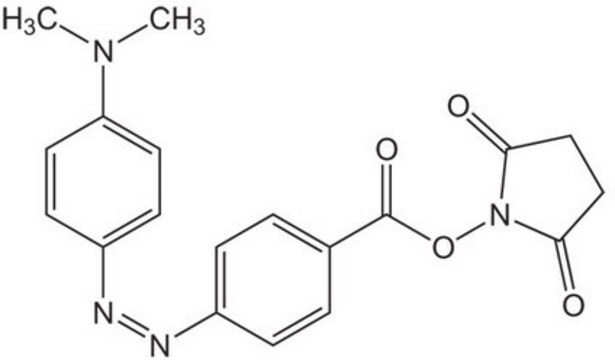77810
Atto 520 NHS ester
BioReagent, suitable for fluorescence, ≥90% (HPLC)
About This Item
Produits recommandés
Gamme de produits
BioReagent
Essai
≥90% (HPLC)
≥90% (degree of coupling)
Forme
powder
Fabricant/nom de marque
ATTO-TEC GmbH
λ
in ethanol (with 0.1% trifluoroacetic acid)
Absorption UV
λ: 526-532 nm Amax
Adéquation
suitable for fluorescence
Méthode de détection
fluorometric
Température de stockage
−20°C
Chaîne SMILES
[O-]Cl(=O)(=O)=O.CCNc1cc2OC3=CC(=[NH+]\CC)\C(C)=CC3=C(CCC(=O)ON4C(=O)CCC4=O)c2cc1C
InChI
1S/C26H29N3O5.ClHO4/c1-5-27-20-13-22-18(11-15(20)3)17(7-10-26(32)34-29-24(30)8-9-25(29)31)19-12-16(4)21(28-6-2)14-23(19)33-22;2-1(3,4)5/h11-14,27H,5-10H2,1-4H3;(H,2,3,4,5)/b28-21-;
Clé InChI
HVCUIKJJDQLPQR-AYYDQZPKSA-N
Vous recherchez des produits similaires ? Visite Guide de comparaison des produits
Application
Informations légales
Code de la classe de stockage
13 - Non Combustible Solids
Classe de danger pour l'eau (WGK)
WGK 3
Point d'éclair (°F)
Not applicable
Point d'éclair (°C)
Not applicable
Équipement de protection individuelle
Eyeshields, Gloves, type N95 (US)
Faites votre choix parmi les versions les plus récentes :
Déjà en possession de ce produit ?
Retrouvez la documentation relative aux produits que vous avez récemment achetés dans la Bibliothèque de documents.
Les clients ont également consulté
Notre équipe de scientifiques dispose d'une expérience dans tous les secteurs de la recherche, notamment en sciences de la vie, science des matériaux, synthèse chimique, chromatographie, analyse et dans de nombreux autres domaines..
Contacter notre Service technique




![4-[4-(Dimethylamino)phenylazo]benzoic acid N-succinimidyl ester ≥98.0% (HPLC)](/deepweb/assets/sigmaaldrich/product/structures/120/235/500b5276-3ce2-43b7-9588-3883f13d4ff7/640/500b5276-3ce2-43b7-9588-3883f13d4ff7.png)

